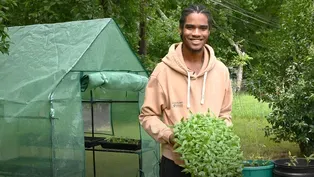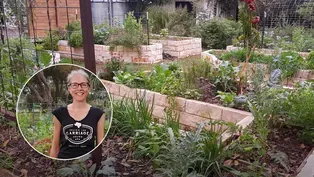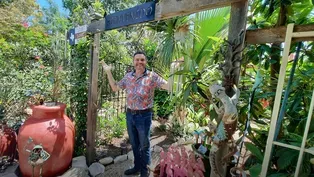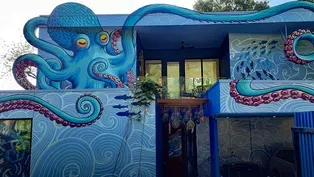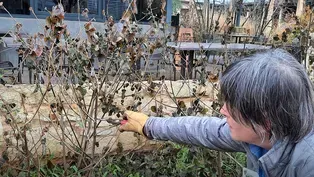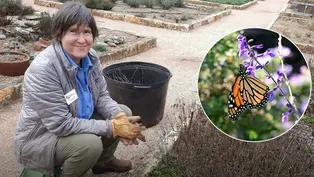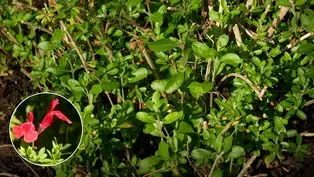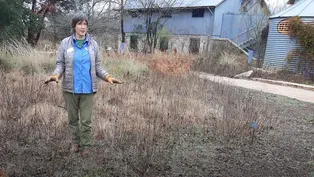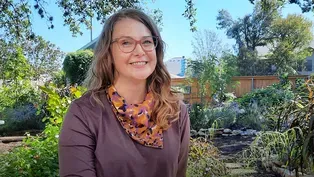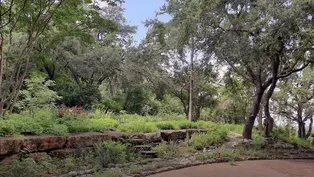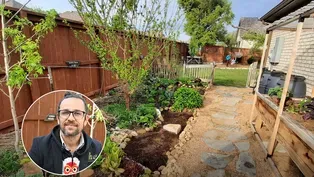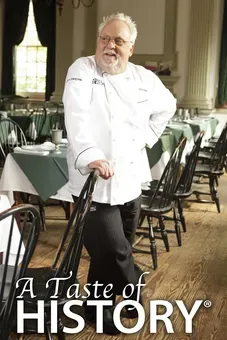
One Bed at a Time!
Clip: Season 28 | 7m 49sVideo has Closed Captions
New gardener Nancy Hall relied on plants–adapted and native–to teach her their ways.
When Nancy Hall bought her house in 1985, the heavy clay soil hosted a lawn and a stark chain link fence. As a new gardener, the plants–both adapted and native–taught her their ways. Gradually, she layered foliage and flowers, accented with artwork from local artists. Then she added a small pond and inviting patio to watch all the wildlife that come visit.
Problems with Closed Captions? Closed Captioning Feedback
Problems with Closed Captions? Closed Captioning Feedback
Central Texas Gardener is a local public television program presented by Austin PBS
Support for CTG is provided by: Lisa & Desi Rhoden, and Diane Land & Steve Adler. Central Texas Gardener is produced by Austin PBS, KLRU-TV and distributed by NETA.

One Bed at a Time!
Clip: Season 28 | 7m 49sVideo has Closed Captions
When Nancy Hall bought her house in 1985, the heavy clay soil hosted a lawn and a stark chain link fence. As a new gardener, the plants–both adapted and native–taught her their ways. Gradually, she layered foliage and flowers, accented with artwork from local artists. Then she added a small pond and inviting patio to watch all the wildlife that come visit.
Problems with Closed Captions? Closed Captioning Feedback
How to Watch Central Texas Gardener
Central Texas Gardener is available to stream on pbs.org and the free PBS App, available on iPhone, Apple TV, Android TV, Android smartphones, Amazon Fire TV, Amazon Fire Tablet, Roku, Samsung Smart TV, and Vizio.
Providing Support for PBS.org
Learn Moreabout PBS online sponsorship- I've always loved gardening.
I bought the house in 1985, and I was so excited because the first thing I wanted to do was to get out in the yard and start digging in the dirt.
(Nancy laughing) I never get tired of, I love the feel of the dirt in my hands.
When I got here, the house was a wreck, and there were no flower beds at all.
It was just some grass and stuff.
Over the years it's developed and changed.
Like the beds in the back, that big perennial bed I have, well the first third of it, I was out there digging one day, and at the time there was just a little metal fence.
We didn't have the privacy fence.
And there was an elderly coupled that lived back there, and the man had retired, but he liked to work outdoors, and so he saw me digging, and he went, "Nancy, I love to work outdoors.
"Can I help you?"
So he came over the fence and started digging up a whole bunch of the land for me.
There was a teenage boy who lived across the street, and he was always anxious to earn some money.
So, he came over and helped me dig.
Someone from University of Texas, where I worked for a long time, a student, was trying to earn money.
So she helped me build the, dig up the third section.
(laughing) It was that Blackland Prairie, which was clay, has a whole lot of clay in it.
And when it would get wet you could almost mold it.
So, over the years I just slowly added more and more compost.
However, there are some plants that will grow in that Blackland Prairie stuff and you don't have to do anything to.
And I've never amended the soil.
If you get the right type of plant, you don't have to amend the soil.
But I did, for the most part, the big perennial bed I have amended over the years with a whole lot of compost.
'Cause it does keep that soil real loose.
'Cause you know, it would rain, it would get all soggy, and the plants, some of the plants weren't very happy.
Lavender, I have tried and tried to grow lavender.
I've made special beds, I've done the whole thing.
Can't grow lavender.
(laughing) But I try to stick to native plants or plants that are adapted to this area.
That always helps.
My mother was a big gardener.
She loved to garden.
In fact, when she'd come visit me, she'd be outside working in my yard.
And I lived in a small town that had farms, one right next to me, 'cause we lived on a dead end, and at the other end of the block there was a big farm.
I think that probably inspired me.
And one of the farms had a pecan grove and every spring, this giant field of daffodils.
They were so pretty.
So with all that, I got my house, and I went, "Oh yay, I get to go out and dig in the dirt.
"How fun."
Well the first thing I built was the sidewalk along the house, and it goes to my shed.
There was a path and it was mud and it was a mess.
And so I had some people from Georgetown, a landscape company, and they came out and did all of this.
And they had a mason who was wonderful, who did great work.
Fairly recently I had him do a patio, which was a blessing.
Looks real pretty, too.
And then I got this table to go on the patio.
And then just recently I had the sidewalk from here on the west side of my house.
I just recently had that done, too.
I mean, just piecing this together is a work of art, getting it to look really nice.
And, and you know, it's funny, when I planted the plants, I didn't really, I just went out there and planted.
I mean I tried to kind of put the taller plants at the back and the lower plants of course at the front, but I didn't really have any plan.
I just kind of planted stuff.
And then if it did really well, great.
If it didn't, I would either move it, 'cause I have a rosebush I moved three times before I found the perfect spot for it, or I would just go, well this plant's not gonna work so I'm gonna try something else.
And you have to kind of find the right spot for your plants.
Nurseries now are having more native plants, and more, well it says adapted.
I have more butterflies.
I have a lot of hummingbirds.
Bees love my yard and they love my pond.
I had a friend that moved down, a young man, he moved down from New Jersey.
He moved down here 'cause his cousin was here, and he needed a place to live.
And so I had an extra bedroom and bath, and I said, "Well you can live here," you know, "until you find someplace to live, an apartment."
And I wasn't charging him any rent.
So, one day he just said, "Nancy, you need a pond."
He was interested in landscaping and had made a pond for his mother.
I think that was the only pond he had done.
And so he just got out there one day with the shovel and just started digging, digging and making platforms.
He loved landscaping, and while he was here, he took a couple, he went to ACC and took a couple landscaping courses.
My pond is very popular with the squirrels and the birds and all kinds of animals I see in that pond.
They love the water.
And in my fountain, too.
And the birds are in the water.
And the squirrels, I see everyone.
Everyone drinks outta those.
So that's nice for the wildlife.
And I have frogs.
Once a year, I have frogs that make out in that pond and make a lot of noise at night.
They have their big party at nighttime and croak and croak and croak.
And at first it bothered me, and then I just went, okay, Nancy, just kinda let the frog sing you to sleep.
So, it's, you know, I don't even notice it anymore.
But I love the sound of the water, and so, and any garden or pond or anything is gonna take a lotta work.
But it's something I love to do.
And I'm retired now, so I've got time to do it.
I worked in the nursing school in the Learning Resource Center as a librarian, a media librarian.
So I worked there for 35 years.
I guess the main thing is that I love to intersperse artwork into my garden.
I think that's an important component.
Over the years I've collected art from a lot of artists from Austin, just from all around.
I like artwork anyway.
I always go on art tours and art museums.
And so I just think that kinda adds to the flavor of my garden area.
Kinda makes it a little bit unique, I think.
It's not just plants.
It's plants and artwork, and sometimes it's hard to find artwork that will go outside.
But I've found quite a bit over the years.
The baby bears came from a woman named Cat Quintanilla, who has a studio in South Austin.
I love the little bears with the turquoise eyes.
And so then I had commissioned the fish.
I've got fish by the same lady that are by the pond.
Gardener Girl is a replica of a woman named Sylvia White Judson, who was a famous sculptor and whose work is in the White House Gardens, in Jackie Kennedy's garden.
And I also have a lot of mosaic in the garden.
I've got mosaic stones and two mosaic benches, and one of them was done by a lady in Bertram.
I guess I've always been into art, because my father was really big into art museums.
Wherever we went we would go to the art museum.
And so I've always liked art.
I have a lot of art in my house.
I just think it's kind of like an art museum.
It's a plant museum with art everywhere.
That's just one of my big themes.
I'm always looking for something else that I can put up that would be art that goes outside.
Yeah, yeah.
Growing Community: Body and Soul
Video has Closed Captions
Lenny West found his anchor and mission in providing fresh vegetables to food desert neighbors. (6m 18s)
Native Plant Garden in HOA: Martin Byhower
Video has Closed Captions
A California-to-Texas environmentalist helps neighbors garden for wildlife in extreme weather. (8m 42s)
Permaculture Design: Raised Beds and Food Forest
Video has Closed Captions
Limestone raised beds and a mandala-designed food forest honor resourceful permaculture tenets. (9m 15s)
Creating Moods in a Regular Backyard
Video has Closed Captions
Imagination, creative reuse, and spirited fun turned a backyard into a sensory voyage. (7m 41s)
Video has Closed Captions
New gardener Nancy Hall relied on plants–adapted and native–to teach her their ways. (7m 49s)
Artistic Collaboration Goes with the Flow
Video has Closed Captions
When rainwater runoff plagued a family’s home, they plunged into a whimsical makeover. (8m 25s)
Winter Pruning: Wax Mallow for Spring’s Spiderworts
Video has Closed Captions
See how to cut back wax mallow (turk’s cap) to show off spring-blooming spiderworts. (3m 25s)
Winter Pruning: Mealy Blue Sage
Video has Closed Captions
See where to cut back old stalks on perennial mealy blue sage. (3m 16s)
Video has Closed Captions
Learn how to prune this evergreen woody shrub/subshrub. (4m 47s)
Video has Closed Captions
See why to progressively prune grasses and herbaceous perennials. (1m 35s)
Garden Makeover Grows New Friends and Career
Video has Closed Captions
Jennie Ostertag broke a few shovels changing her yard and life’s path. (9m 18s)
Video has Closed Captions
James Truchard created diverse habitats to offset a future of climate changes. (8m 49s)
Drought Design: Change of Plans & Plants
Video has Closed Captions
Mistakes led new gardeners back to the drawing board with native plants. (8m 55s)
Side Yard Garden Permaculture Design
Video has Closed Captions
A narrow side yard supports food and flowers with permaculture techniques. (8m 1s)
Front Yard Native Plant Wildlife Habitat
Video has Closed Captions
Removing lawn for native plants brings pollinators to a young couple’s front yard. (9m 35s)
Providing Support for PBS.org
Learn Moreabout PBS online sponsorshipSupport for PBS provided by:
Central Texas Gardener is a local public television program presented by Austin PBS
Support for CTG is provided by: Lisa & Desi Rhoden, and Diane Land & Steve Adler. Central Texas Gardener is produced by Austin PBS, KLRU-TV and distributed by NETA.
